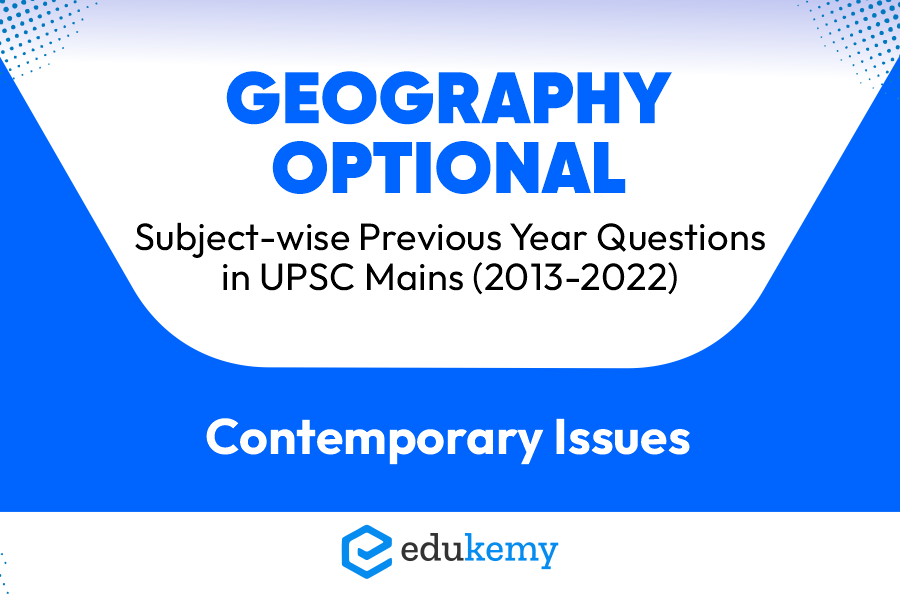
Geography as a field of study is concerned with understanding the interrelationship between humans and the natural environment, and as such, it is important to be aware of the contemporary issues that affect our planet. These issues range from environmental, social, economic, and political challenges that we face today and that have far-reaching consequences for the future.
One of the major contemporary issues in geography is climate change. Human activities such as burning fossil fuels, deforestation, and agriculture have led to an increase in atmospheric carbon dioxide and other greenhouse gases, resulting in global warming and climate change. This has led to changes in weather patterns, rising sea levels, and an increase in extreme weather events.
Another important issue in geography is urbanization. With the world’s population projected to reach 9 billion by 2050, the number of people living in cities is expected to increase significantly. This poses challenges for infrastructure, resource management, and social and economic inequality.
Food security is also a major issue in geography, with many parts of the world experiencing food shortages due to climate change, environmental degradation, and socio-economic factors. The global population is expected to increase, putting further pressure on the world’s food supply, and sustainable food production and distribution systems will be crucial to meeting the growing demand.
Other contemporary issues in geography include energy security, water scarcity, migration and refugee crises, geopolitical tensions, and the impacts of globalization on cultures and economies.
Overall, being aware of these contemporary issues is crucial for anyone interested in geography, as they impact the world we live in and will continue to shape our planet for generations to come.
Get the Geography Optional Hard Copy Notes of Shabbir Sir’s most recent batch: Here
Contemporary Issues Previous Year Questions (UPSC CSE Mains Geography Optional)
- Why has extreme particulate pollution remained a festering issue in Delhi NCR region? (10 Marks/2022)
- The process of desertification leads to soil desiccation and soil loss. Explain. (10 Marks/2022)
- Groundwater contamination in the fast-expanding urban landscape of India appears to have become a major public health issue. Discuss. (15 Marks/2022)
- Evaluate the role of the National Food Security Act, 2013 in providing access of food to the poor in India. (15 Marks/2022)
- Landslide is a major problem in Himalayan region. Discuss its causes and mitigation measures. (20 Marks/2021)
- Appraise why drought is one of the most common climatic extremes in India. (15 Marks/2021)
- Discuss the ecological and economic challenges of river linking in India. (15 Marks/2021)
- Discuss the salient features of Project Tiger in India. (10 Marks/2021)
- Describe the problems of cloud burst in India giving suitable examples. (10 Marks/2021)
- Discuss the methods of crop residue management in rural India to reduce pollution. (10 Marks/2020)
- Stunting and wasting among children are major consequences of food insecurity. Discuss various schemes of Government of India to address these problems and their achievements. (15 Marks/2020)
- Digital Divide in India needs quick redressal to reduce regional disparity in development. Elaborate with suitable examples. (20 Marks/2020)
- Avalanche is a major hazard in the Himalayas. What are its causes and mitigation measures? (15 Marks/2020)
- Demarcating the seismic zones of India, suggest suitable interventions required in most sensitive seismic zones for sustainable human settlements. (20 Marks/2020)
- Examine the problems of Glacial Lake Outburst Flood (GLOF) in India. (10 Marks/2019)
- “Intrabasins linkages of rivers are more feasible economically, socially and ecologically”. Discuss with suitable examples from India. (20 Marks/2019)
- Give a reasoned account of high levels of pollution in North Indian cities as compared to South Indian cities. (15 Marks/2019)
- Describe the altitudinal and spatial geo-environmental hazards in the Himalayas. (15 Marks/2019)
- Explain the changing river courses and their impacts on the riparian population in India with suitable examples. (10 Marks/2018)
- Make a critical appraisal of the factors affecting river water quality in India. (10 Marks/2018)
- Describe the socio-spatial consequences of the recent Nipah viral encephalitis in India. (10 Marks/2018)
- Farmers’ suicide is one of the major agrarian problems in India. Bring out its causes and suggest the remedial measures with special reference to Maharashtra,Andhra Pradesh and Punjab. (15 Marks/2017)
- Inter-linking of rivers may serve as a major source of assured irrigation and allweather inland navigation in India. Comment on its feasibility taking into account physical, economic and ecological implications. (20 Marks/2017)
- What do you understand by soil pollution? Delineate the areas vulnerable to it in India and suggest remedial measures. (15 Marks/2017)
- Describe the flood-prone areas and their management problems in the Ganga plains. (15 Marks/2016)
- Explain the impact of economic development on environmental degradation in India. (15 Marks/2016)
- Examine the causes of regional disparities in economic development in India. (15 Marks/2016)
- Account for the growing frequency and intensity of floods in India, and suggest short and long-term remedial measures indicating the chronically flood-prone areas. (20 Marks/2015)
- How does climate change affect the process of desertification of India? (15 Marks/2015)
- Explain how change in land use can promote eco-development at different levels in the country. (10 Marks/2015)
- Suggest the measures of wild-life conservation with reference to extinction ofrare species.(15 Marks/2014)
- Explain the concept of ‘Make in India’ and indicate the essential inputs for its success. (15 Marks/2014)
- Differentiate between ‘intensity’ and‘magnitude’ of an earthquake and explain its varying impact in different parts of India. (15 Marks/2014)
- How has an inappropriate urban land use policy accounted for undesirable development in and around
- metropolitan cities? (15 Marks/ 2014)
- Comment on the feasibility of interlinking of rivers of India and its possible contribution to resolution of water crisis. (20 Marks/2013)
- Snags in the Food Security Policy of India. (10 Marks/2013)
- Identify the earthquake-prone zones and suggest strategy for their management. (20 Marks/2013)
- Describe how urbanization creates air and water pollution in India. (15 Marks/2013)
Read our SOLVED PAPERS.
Frequently Asked Questions (FAQs)
1. Question: What are the key contemporary issues covered in the Geography optional subject for UPSC Mains from 2013 to 2022?
Answer: The Geography optional subject in UPSC Mains from 2013 to 2022 has extensively covered contemporary issues such as climate change, urbanization, regional imbalances, sustainable development, and geopolitical challenges. Questions often revolve around the impact of these issues on various geographical regions and their implications.
2. Question: How important is the knowledge of current affairs in tackling Geography optional questions in UPSC Mains?
Answer: Current affairs play a crucial role in Geography optional preparation for UPSC Mains. Questions often require candidates to apply theoretical knowledge to real-world scenarios. Being updated on contemporary issues enhances the analytical and critical thinking skills necessary to address the evolving challenges in geography.
3. Question: Are there specific regions or countries that have been consistently addressed in the Geography optional questions over the past decade?
Answer: Yes, the Geography optional questions in UPSC Mains often focus on regions or countries facing significant geographical challenges. These may include areas experiencing environmental degradation, geopolitical tensions, demographic shifts, or economic transformations. Candidates should be well-versed in global and regional geography to answer such questions effectively.
4. Question: How can candidates integrate interdisciplinary knowledge into their Geography optional preparation for contemporary issues?
Answer: Contemporary issues in geography often require an interdisciplinary approach. Candidates should integrate knowledge from diverse fields such as environmental science, economics, sociology, and international relations. This multidimensional understanding enhances the quality of responses and demonstrates a holistic perspective on the challenges addressed in the questions.
5. Question: How has the format of Geography optional questions on contemporary issues evolved over the years, and how should candidates adapt their preparation strategies?
Answer: The format of questions has evolved to be more application-oriented and case-study-based. Candidates should focus on developing a nuanced understanding of geographical concepts and their real-world applications. Regular practice through solving previous year questions and mock tests is essential to adapt to the changing pattern and enhance problem-solving skills.

For UPSC Prelims Resources, Click here
For Daily Updates and Study Material:
Join our Telegram Channel – Edukemy for IAS
- 1. Learn through Videos – here
- 2. Be Exam Ready by Practicing Daily MCQs – here
- 3. Daily Newsletter – Get all your Current Affairs Covered – here
- 4. Mains Answer Writing Practice – here
Visit our YouTube Channel – here

